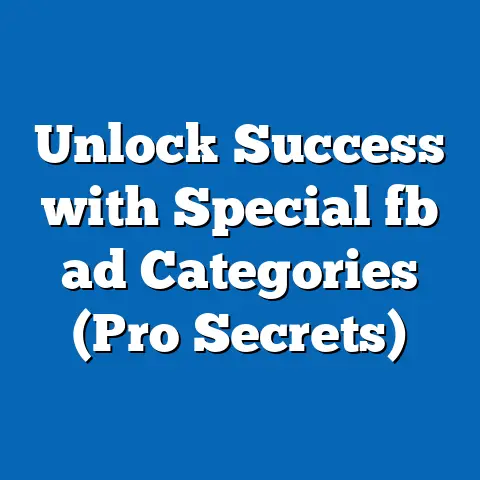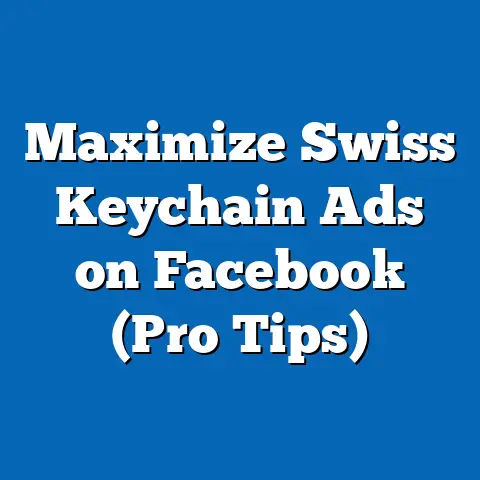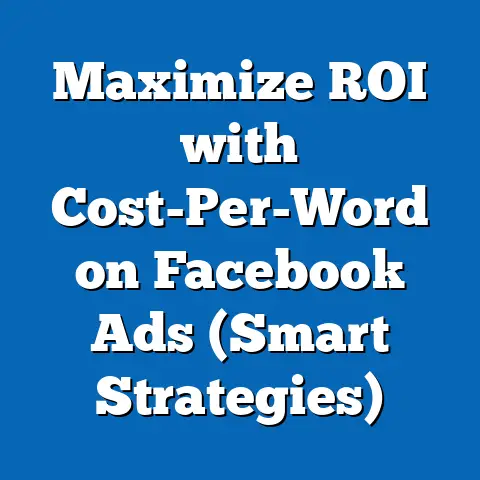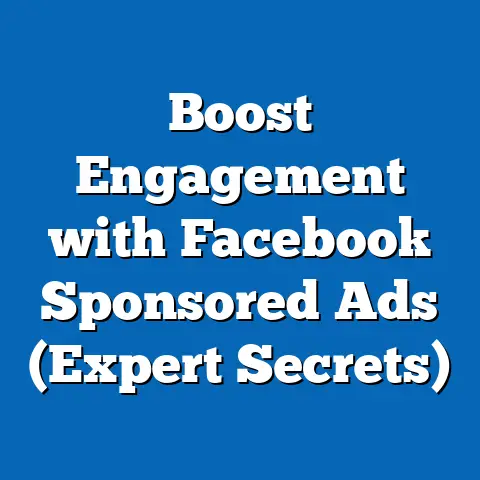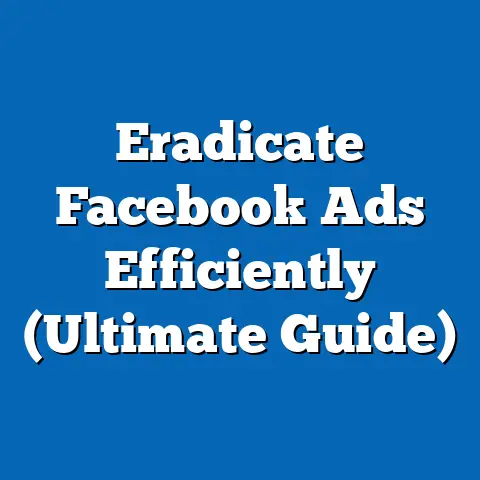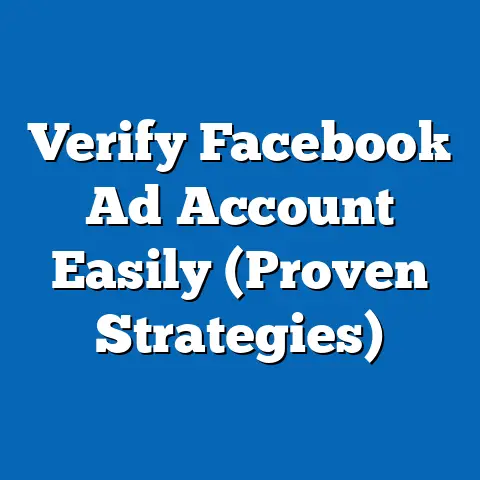Boost Ad Success (Proven Facebook Strategies)
The digital landscape is a constantly shifting terrain, and for businesses today, navigating it effectively is more critical than ever. We’re not just talking about having a website and a social media presence anymore. We’re talking about strategic, data-driven advertising that cuts through the noise and connects with the right audience. And in that arena, Facebook advertising remains a powerhouse. I’ve seen firsthand how impactful a well-executed Facebook campaign can be, turning small businesses into thriving enterprises and helping established brands solidify their market position.
However, simply throwing money at Facebook ads and hoping for the best is a recipe for disaster. The platform is complex, consumer behavior is constantly evolving, and competition is fierce. That’s why understanding the nuances of Facebook advertising, from identifying your ideal customer to crafting compelling ad copy and leveraging the latest trends, is crucial for success.
According to Statista, Facebook reported 2.91 billion monthly active users as of the first quarter of 2024. This vast reach makes Facebook an unparalleled platform for businesses to connect with potential customers. But reach alone isn’t enough. You need a strategy, a plan, and a deep understanding of how to leverage Facebook’s advertising tools to your advantage.
In this article, I’m going to share proven Facebook advertising strategies that I’ve personally used and refined over years of experience. We’ll cover everything from the basics of the Facebook advertising ecosystem to advanced techniques like retargeting and A/B testing. My goal is to equip you with the knowledge and tools you need to not just create ads, but to create successful ads that drive real results for your business.
Section 1: Understanding the Facebook Advertising Ecosystem
Before diving into specific strategies, it’s essential to grasp the fundamentals of the Facebook advertising ecosystem. Think of it as a complex machine with many moving parts, each playing a vital role in the overall process.
At its core, Facebook advertising allows you to promote your business, products, or services to a highly targeted audience based on their demographics, interests, behaviors, and more. What sets Facebook apart from traditional advertising is its unparalleled level of precision. You’re not just broadcasting your message to the masses; you’re carefully selecting who sees it based on their likelihood to be interested in what you have to offer.
Diving into Ad Types: Finding the Right Fit
Facebook offers a diverse range of ad formats, each designed to achieve different objectives. Here’s a breakdown of some of the most popular options:
-
Image Ads: These are the simplest and most common type of Facebook ad, featuring a single image and accompanying text. They’re great for showcasing products, promoting events, or driving traffic to your website. I’ve found that high-quality, visually appealing images are key to grabbing attention in the crowded newsfeed.
-
Video Ads: Video ads are incredibly engaging and can be used to tell stories, demonstrate products, or share customer testimonials. They often have higher engagement rates than image ads, especially when the video is short, attention-grabbing, and mobile-optimized. I’ve seen video ads significantly boost brand awareness and drive conversions for many of my clients.
-
Carousel Ads: Carousel ads allow you to showcase multiple images or videos within a single ad unit. This format is perfect for highlighting different features of a product, showcasing multiple products in a collection, or telling a story across multiple cards. I’ve used carousel ads to effectively showcase product ranges and guide users towards specific items on e-commerce sites.
-
Collection Ads: These ads are designed for mobile users and feature a hero image or video at the top, followed by a grid of related products. They’re ideal for e-commerce businesses looking to drive sales directly from the Facebook newsfeed. Collection ads provide a seamless shopping experience, allowing users to browse products and make purchases without leaving the Facebook app.
-
Lead Ads: Lead ads are designed to collect leads directly from Facebook without requiring users to visit your website. They feature a pre-filled form that users can submit with just a few taps, making it incredibly easy for them to express interest in your product or service. I’ve found lead ads to be particularly effective for businesses offering services like consultations, quotes, or demos.
Image Ads: These are the simplest and most common type of Facebook ad, featuring a single image and accompanying text. They’re great for showcasing products, promoting events, or driving traffic to your website. I’ve found that high-quality, visually appealing images are key to grabbing attention in the crowded newsfeed.
Video Ads: Video ads are incredibly engaging and can be used to tell stories, demonstrate products, or share customer testimonials. They often have higher engagement rates than image ads, especially when the video is short, attention-grabbing, and mobile-optimized. I’ve seen video ads significantly boost brand awareness and drive conversions for many of my clients.
Carousel Ads: Carousel ads allow you to showcase multiple images or videos within a single ad unit. This format is perfect for highlighting different features of a product, showcasing multiple products in a collection, or telling a story across multiple cards. I’ve used carousel ads to effectively showcase product ranges and guide users towards specific items on e-commerce sites.
Collection Ads: These ads are designed for mobile users and feature a hero image or video at the top, followed by a grid of related products. They’re ideal for e-commerce businesses looking to drive sales directly from the Facebook newsfeed. Collection ads provide a seamless shopping experience, allowing users to browse products and make purchases without leaving the Facebook app.
Lead Ads: Lead ads are designed to collect leads directly from Facebook without requiring users to visit your website. They feature a pre-filled form that users can submit with just a few taps, making it incredibly easy for them to express interest in your product or service. I’ve found lead ads to be particularly effective for businesses offering services like consultations, quotes, or demos.
Navigating Facebook Ads Manager: Your Control Center
The Facebook Ads Manager is your command center for creating, managing, and analyzing your Facebook ad campaigns. It’s a powerful tool that provides a wealth of features and options, but it can also be overwhelming for beginners.
The Ads Manager interface is organized into three main levels:
-
Campaigns: This is the highest level, where you define your overall advertising objective (e.g., brand awareness, website traffic, lead generation).
-
Ad Sets: Ad sets define your target audience, budget, schedule, and placement (where your ads will appear, such as Facebook, Instagram, or Audience Network).
-
Ads: This is where you create your individual ads, including the ad copy, visuals, and call to action.
Campaigns: This is the highest level, where you define your overall advertising objective (e.g., brand awareness, website traffic, lead generation).
Ad Sets: Ad sets define your target audience, budget, schedule, and placement (where your ads will appear, such as Facebook, Instagram, or Audience Network).
Ads: This is where you create your individual ads, including the ad copy, visuals, and call to action.
Understanding this hierarchical structure is crucial for organizing your campaigns effectively and optimizing them for maximum performance. I always recommend starting with a clear objective in mind and then working your way down, carefully defining your target audience and crafting compelling ads that resonate with them.
Takeaway: The Facebook advertising ecosystem is vast and complex, but understanding its core components is essential for success. Experiment with different ad types to find the ones that work best for your business and familiarize yourself with the Facebook Ads Manager interface.
Section 2: Identifying Target Audiences
One of the most significant advantages of Facebook advertising is its ability to target specific audiences with laser-like precision. No more wasting money on ads that reach people who are completely uninterested in what you have to offer. With Facebook, you can focus your efforts on the people who are most likely to become your customers.
Defining Your Ideal Customer: The Foundation of Targeting
Before you can start targeting your audience on Facebook, you need to have a clear understanding of who your ideal customer is. This involves creating a detailed customer persona that includes their demographics, interests, behaviors, pain points, and goals.
Ask yourself questions like:
- What is their age, gender, location, and education level?
- What are their interests, hobbies, and passions?
- What websites do they visit, and what products do they buy?
- What are their biggest challenges and frustrations?
- What are their aspirations and dreams?
The more detailed your customer persona is, the better equipped you’ll be to target your ads effectively on Facebook. I often advise my clients to conduct customer surveys, interview existing customers, and analyze their website analytics to gather insights into their target audience.
Leveraging Facebook Audience Insights: Uncovering Hidden Gems
Facebook Audience Insights is a powerful tool that provides valuable data about your target audience, including their demographics, interests, behaviors, and purchase habits. It allows you to explore the characteristics of people who are connected to your Facebook page, as well as people who are interested in specific topics or brands.
With Audience Insights, you can:
- Identify the top interests and pages that your target audience likes.
- Discover their demographic breakdown, including age, gender, location, and relationship status.
- Learn about their purchase behavior, including their preferred payment methods and online spending habits.
- Understand their lifestyle and how they use Facebook.
This information can be invaluable for refining your targeting strategy and creating ads that resonate with your audience. I’ve used Audience Insights to uncover hidden interests and behaviors that I wouldn’t have otherwise considered, leading to significant improvements in ad performance.
Creating Custom Audiences: Reaching Your Existing Customers
Custom audiences allow you to target your existing customers and website visitors with Facebook ads. You can create custom audiences based on:
- Customer Lists: Upload a list of your customer email addresses or phone numbers to target them directly on Facebook.
- Website Traffic: Target people who have visited your website or specific pages on your website.
- App Activity: Target people who have used your mobile app or taken specific actions within your app.
- Engagement: Target people who have interacted with your Facebook page, ads, or videos.
Custom audiences are incredibly powerful because they allow you to reach people who are already familiar with your brand and have expressed interest in your products or services. I’ve seen custom audiences significantly increase conversion rates and drive repeat purchases for my clients.
Building Lookalike Audiences: Expanding Your Reach
Lookalike audiences allow you to target people who are similar to your existing customers or website visitors. Facebook analyzes the characteristics of your source audience (e.g., customer list, website visitors) and identifies other Facebook users who share similar demographics, interests, and behaviors.
Lookalike audiences are a great way to expand your reach and find new potential customers who are likely to be interested in your business. I typically recommend starting with a small lookalike audience (e.g., 1-2% of the population) and gradually increasing the size as you optimize your campaigns.
Takeaway: Targeting the right audience is crucial for Facebook advertising success. Define your ideal customer, leverage Facebook Audience Insights, and create custom and lookalike audiences to reach the people who are most likely to become your customers.
Section 3: Crafting Compelling Ad Content
Even with the most precise targeting in the world, your ads will fall flat if the content isn’t compelling. In today’s fast-paced digital world, you have mere seconds to grab someone’s attention and convince them to take action. That’s why crafting ad copy and visuals that are both engaging and relevant is essential.
Mastering the Art of Ad Copy: Headlines, Descriptions, and CTAs
Your ad copy is your opportunity to communicate the value of your product or service to your target audience. It should be clear, concise, and persuasive, highlighting the benefits of what you have to offer and encouraging people to take action.
Here are some key elements of successful ad copy:
-
Headlines: Your headline is the first thing people will see, so it needs to be attention-grabbing and relevant to their interests. Use strong verbs, numbers, and questions to pique their curiosity. For example, instead of “New Product Launch,” try “Discover the Secret to [Desired Outcome] in Just 7 Days!”
-
Descriptions: Your description should provide more detail about your product or service, highlighting its key features and benefits. Focus on solving a problem or fulfilling a need for your target audience. Use persuasive language and social proof (e.g., testimonials, reviews) to build trust and credibility.
-
Calls to Action (CTAs): Your CTA is the final nudge that encourages people to take the desired action, whether it’s visiting your website, making a purchase, or signing up for a newsletter. Use clear and specific CTAs that tell people exactly what you want them to do. Examples include “Shop Now,” “Learn More,” “Get a Free Quote,” or “Download Now.”
Headlines: Your headline is the first thing people will see, so it needs to be attention-grabbing and relevant to their interests. Use strong verbs, numbers, and questions to pique their curiosity. For example, instead of “New Product Launch,” try “Discover the Secret to [Desired Outcome] in Just 7 Days!”
Descriptions: Your description should provide more detail about your product or service, highlighting its key features and benefits. Focus on solving a problem or fulfilling a need for your target audience. Use persuasive language and social proof (e.g., testimonials, reviews) to build trust and credibility.
Calls to Action (CTAs): Your CTA is the final nudge that encourages people to take the desired action, whether it’s visiting your website, making a purchase, or signing up for a newsletter. Use clear and specific CTAs that tell people exactly what you want them to do. Examples include “Shop Now,” “Learn More,” “Get a Free Quote,” or “Download Now.”
I always recommend testing different ad copy variations to see what resonates best with your audience. Experiment with different headlines, descriptions, and CTAs to optimize your ads for maximum engagement and conversions.
Show, Don’t Just Tell: The Power of Visuals
Visuals are just as important as ad copy when it comes to capturing attention on Facebook. High-quality images and videos can instantly grab someone’s eye and communicate your message in a visually appealing way.
Here are some tips for creating effective Facebook ad visuals:
-
Use High-Quality Images: Avoid blurry, pixelated images that look unprofessional. Use high-resolution images that are clear, crisp, and visually appealing.
-
Showcase Your Product: If you’re selling a product, show it in action. Use lifestyle images that demonstrate how your product can improve people’s lives.
-
Use Eye-Catching Colors: Use colors that are consistent with your brand but also stand out in the Facebook newsfeed.
-
Keep it Simple: Avoid cluttering your visuals with too much text or graphics. Keep it clean, simple, and easy to understand.
-
Optimize for Mobile: Most Facebook users access the platform on their mobile devices, so make sure your visuals are optimized for mobile viewing.
Use High-Quality Images: Avoid blurry, pixelated images that look unprofessional. Use high-resolution images that are clear, crisp, and visually appealing.
Showcase Your Product: If you’re selling a product, show it in action. Use lifestyle images that demonstrate how your product can improve people’s lives.
Use Eye-Catching Colors: Use colors that are consistent with your brand but also stand out in the Facebook newsfeed.
Keep it Simple: Avoid cluttering your visuals with too much text or graphics. Keep it clean, simple, and easy to understand.
Optimize for Mobile: Most Facebook users access the platform on their mobile devices, so make sure your visuals are optimized for mobile viewing.
I’ve found that videos tend to perform particularly well on Facebook, especially short, attention-grabbing videos that tell a story or demonstrate a product. Consider creating video ads that are specifically designed for mobile viewing, with captions and clear visuals that can be understood even without sound.
The Art of Storytelling: Connecting with Emotions
People are more likely to remember and engage with ads that tell a story. Storytelling can help you connect with your target audience on an emotional level, building trust and creating a lasting impression.
Think about how you can incorporate storytelling into your Facebook ads. Share customer testimonials, highlight the history of your brand, or create a fictional narrative that resonates with your target audience’s values and aspirations.
For example, a local bakery could share the story of how they started their business, highlighting their passion for baking and their commitment to using fresh, local ingredients. This can help them connect with customers who value quality and authenticity.
Takeaway: Compelling ad content is essential for Facebook advertising success. Craft clear, concise, and persuasive ad copy, use high-quality visuals, and incorporate storytelling to connect with your target audience on an emotional level.
Section 4: Leveraging A/B Testing for Optimization
A/B testing, also known as split testing, is a powerful technique that allows you to compare different versions of your ads to see which one performs best. It involves creating two or more variations of your ad, showing them to different segments of your audience, and then analyzing the results to see which version drives the most engagement and conversions.
Why A/B Testing Matters: Data-Driven Decisions
A/B testing is essential for optimizing your Facebook ad campaigns because it allows you to make data-driven decisions based on real-world results. Instead of relying on guesswork or intuition, you can use A/B testing to identify the ad copy, visuals, and targeting options that resonate best with your audience.
By continuously A/B testing different elements of your ads, you can gradually improve their performance over time, leading to higher click-through rates, lower cost per acquisition, and increased return on ad spend.
Setting Up A/B Tests: A Step-by-Step Guide
Facebook Ads Manager makes it easy to set up A/B tests for your ad campaigns. Here’s a step-by-step guide:
-
Choose a Variable to Test: Identify the element of your ad that you want to test, such as the headline, description, image, or CTA.
-
Create Two or More Variations: Create two or more variations of your ad, each with a different version of the variable you’re testing.
-
Set Up Your A/B Test: In Facebook Ads Manager, create a new campaign and select the “A/B Test” objective.
-
Define Your Target Audience: Choose your target audience for the A/B test.
-
Set Your Budget and Schedule: Set your budget and schedule for the A/B test.
-
Analyze the Results: Once the A/B test has run for a sufficient period of time, analyze the results to see which variation performed best.
Choose a Variable to Test: Identify the element of your ad that you want to test, such as the headline, description, image, or CTA.
Create Two or More Variations: Create two or more variations of your ad, each with a different version of the variable you’re testing.
Set Up Your A/B Test: In Facebook Ads Manager, create a new campaign and select the “A/B Test” objective.
Define Your Target Audience: Choose your target audience for the A/B test.
Set Your Budget and Schedule: Set your budget and schedule for the A/B test.
Analyze the Results: Once the A/B test has run for a sufficient period of time, analyze the results to see which variation performed best.
Interpreting A/B Test Results: Making Informed Decisions
When analyzing your A/B test results, pay attention to the following metrics:
-
Click-Through Rate (CTR): This is the percentage of people who saw your ad and clicked on it. A higher CTR indicates that your ad is more engaging and relevant to your audience.
-
Conversion Rate: This is the percentage of people who clicked on your ad and then completed a desired action, such as making a purchase or signing up for a newsletter. A higher conversion rate indicates that your ad is more effective at driving conversions.
-
Cost Per Acquisition (CPA): This is the cost of acquiring one new customer through your ad campaign. A lower CPA indicates that your ad is more cost-effective.
Click-Through Rate (CTR): This is the percentage of people who saw your ad and clicked on it. A higher CTR indicates that your ad is more engaging and relevant to your audience.
Conversion Rate: This is the percentage of people who clicked on your ad and then completed a desired action, such as making a purchase or signing up for a newsletter. A higher conversion rate indicates that your ad is more effective at driving conversions.
Cost Per Acquisition (CPA): This is the cost of acquiring one new customer through your ad campaign. A lower CPA indicates that your ad is more cost-effective.
Based on these metrics, you can determine which variation of your ad performed best and then use that information to optimize your future campaigns. I typically recommend running A/B tests for at least a week to gather enough data to make statistically significant conclusions.
Takeaway: A/B testing is a powerful technique for optimizing your Facebook ad campaigns. Set up A/B tests for different elements of your ads, analyze the results, and make data-driven decisions to improve their performance over time.
Section 5: Utilizing Retargeting Strategies
Retargeting is a highly effective advertising strategy that involves showing ads to people who have previously interacted with your website, app, or Facebook page. It’s based on the principle that people who have already expressed interest in your brand are more likely to convert into customers.
The Power of Second Chances: Re-Engaging Potential Customers
Retargeting allows you to re-engage potential customers who may have visited your website but didn’t make a purchase, or who may have abandoned their shopping cart before completing the checkout process. By showing them relevant ads that remind them of your products or services, you can increase the likelihood that they will come back and convert.
I’ve found that retargeting campaigns can significantly boost conversion rates and drive repeat purchases for my clients. They’re particularly effective for e-commerce businesses that sell products with a longer consideration cycle.
Types of Retargeting Campaigns: Tailoring Your Approach
There are several different types of retargeting campaigns that you can use on Facebook, each designed to target different segments of your audience:
-
Website Retargeting: This involves showing ads to people who have visited your website or specific pages on your website. You can target people who have viewed specific products, added items to their cart, or visited your checkout page.
-
Dynamic Ads: Dynamic ads are personalized ads that automatically show the products that people have previously viewed on your website. They’re particularly effective for e-commerce businesses with large product catalogs.
-
Engagement Retargeting: This involves showing ads to people who have interacted with your Facebook page, ads, or videos. You can target people who have liked your page, commented on your posts, or watched your videos.
Website Retargeting: This involves showing ads to people who have visited your website or specific pages on your website. You can target people who have viewed specific products, added items to their cart, or visited your checkout page.
Dynamic Ads: Dynamic ads are personalized ads that automatically show the products that people have previously viewed on your website. They’re particularly effective for e-commerce businesses with large product catalogs.
Engagement Retargeting: This involves showing ads to people who have interacted with your Facebook page, ads, or videos. You can target people who have liked your page, commented on your posts, or watched your videos.
Creating Effective Retargeting Ads: Personalization is Key
When creating retargeting ads, it’s important to personalize your message to the specific audience you’re targeting. Show them ads that are relevant to their previous interactions with your brand, and highlight the benefits of your products or services that are most likely to appeal to them.
For example, if someone visited your website and viewed a specific product, show them a retargeting ad that features that product and highlights its key features. If they added an item to their cart but didn’t complete the checkout process, show them a retargeting ad that offers a discount or free shipping to encourage them to complete the purchase.
I always recommend using a sense of urgency in your retargeting ads, such as “Limited Time Offer” or “Sale Ends Soon,” to encourage people to take action.
Takeaway: Retargeting is a powerful advertising strategy that allows you to re-engage potential customers who have previously interacted with your brand. Use different types of retargeting campaigns to target different segments of your audience, and personalize your message to the specific audience you’re targeting.
Section 6: Analyzing Performance Metrics
Creating great ads is only half the battle. To truly maximize your Facebook advertising ROI, you need to constantly monitor and analyze your performance metrics to identify what’s working and what’s not.
Key Performance Indicators (KPIs): Measuring Your Success
There are several key performance indicators (KPIs) that you should track to evaluate the success of your Facebook ad campaigns:
- Reach: The number of unique people who saw your ad.
- Impressions: The number of times your ad was displayed.
- Click-Through Rate (CTR): The percentage of people who saw your ad and clicked on it.
- Cost Per Click (CPC): The average cost you paid for each click on your ad.
- Conversion Rate: The percentage of people who clicked on your ad and then completed a desired action, such as making a purchase or signing up for a newsletter.
- Cost Per Acquisition (CPA): The cost of acquiring one new customer through your ad campaign.
- Return on Ad Spend (ROAS): The amount of revenue you generated for every dollar you spent on advertising.
By tracking these KPIs, you can get a clear picture of how your ad campaigns are performing and identify areas for improvement.
Using Facebook Ads Manager for Performance Analysis: A Deep Dive
Facebook Ads Manager provides a wealth of data and reporting tools that you can use to analyze the performance of your ad campaigns. You can customize your reports to track specific metrics, segment your data by demographics, placement, or device, and compare the performance of different ad sets or campaigns.
I always recommend creating custom reports that focus on the KPIs that are most important to your business goals. For example, if your goal is to generate leads, you should focus on tracking metrics like cost per lead and lead conversion rate.
Making Iterative Improvements: The Path to Optimization
The key to optimizing your Facebook ad campaigns is to make iterative improvements based on performance data. Continuously monitor your KPIs, identify areas for improvement, and then make small changes to your ads, targeting, or bidding strategy.
For example, if you notice that your click-through rate is low, you could try testing different headlines or visuals to see if you can improve engagement. If you notice that your cost per acquisition is high, you could try refining your targeting or adjusting your bidding strategy.
I always recommend documenting your changes and tracking the results to see what impact they have on your performance. This will help you learn what works best for your audience and continuously improve your ad campaigns over time.
Takeaway: Analyzing performance metrics is crucial for optimizing your Facebook ad campaigns. Track key performance indicators, use Facebook Ads Manager for performance analysis, and make iterative improvements based on data to enhance ongoing campaigns.
Section 7: Staying Ahead of Trends and Innovations
The world of Facebook advertising is constantly evolving, with new trends and innovations emerging all the time. To stay competitive, it’s essential to stay ahead of the curve and adapt your strategies to take advantage of the latest features and best practices.
The Rise of Short-Form Video Content: Grabbing Attention in Seconds
Short-form video content, such as Reels and TikTok videos, has exploded in popularity in recent years, and Facebook is no exception. These videos are typically short, attention-grabbing, and designed to be consumed on mobile devices.
Consider creating short-form video ads that are specifically designed for the Facebook platform. These videos should be visually appealing, engaging, and optimized for mobile viewing. Use captions and clear visuals that can be understood even without sound.
Augmented Reality (AR) Ads: Immersive Experiences
Augmented reality (AR) ads are a relatively new type of ad that allows users to interact with your products in a virtual environment. For example, a furniture retailer could create an AR ad that allows users to see what a piece of furniture would look like in their home before they buy it.
AR ads offer a unique and immersive experience that can help you stand out from the competition and drive higher engagement rates.
The Power of Personalization: Tailoring Your Message
Personalization is becoming increasingly important in Facebook advertising. Consumers are more likely to respond to ads that are relevant to their interests and needs.
Use data to personalize your ads to the specific audience you’re targeting. Show them ads that feature products they’ve previously viewed, offer discounts on items they’ve purchased before, or highlight the benefits of your products that are most likely to appeal to them.
Embracing Emerging Technologies: The Future of Advertising
The future of Facebook advertising is likely to be shaped by emerging technologies like artificial intelligence (AI) and machine learning (ML). These technologies can be used to automate tasks, personalize ads, and optimize campaigns for maximum performance.
Stay up-to-date on the latest trends and innovations in Facebook advertising, and be willing to experiment with new features and technologies to stay ahead of the competition.
Takeaway: Staying ahead of trends and innovations is essential for Facebook advertising success. Embrace short-form video content, explore augmented reality ads, and leverage the power of personalization to stay competitive.
Conclusion:
Boosting ad success on Facebook requires a multifaceted approach that combines strategic planning, compelling content creation, data-driven optimization, and a willingness to adapt to the ever-changing landscape. By understanding the Facebook advertising ecosystem, identifying your target audience, crafting compelling ad content, leveraging A/B testing, utilizing retargeting strategies, analyzing performance metrics, and staying ahead of trends and innovations, you can significantly enhance your Facebook ad campaigns and achieve your marketing goals.
Remember, Facebook advertising is not a “set it and forget it” activity. It requires continuous monitoring, analysis, and optimization to achieve the best possible results. Be adaptable, proactive, and always be willing to experiment with new strategies and techniques.
I encourage you to implement these proven strategies in your own Facebook ad campaigns and track your results. The more you learn and adapt, the more successful you’ll be at reaching your target audience, driving conversions, and achieving your business objectives. The digital landscape is dynamic, and your Facebook advertising strategy should be too. By embracing these proven strategies and staying adaptable, you can unlock the full potential of Facebook advertising and drive meaningful results for your business.

